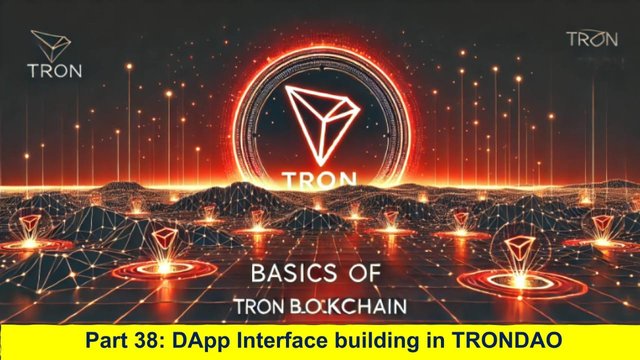Basics of Tron (Part 38) : DApp Interface Building in TronDAO
Intro
IntroThe Tron Fan Club community works with people who love Tron Blockchain and are interested in blockchain technology. As a moderator of the community, I am regularly sharing the details of Tron with you. Our knowledge on any subject is enough. So, it’s a knowledge sharing opportunity for all of us. This community is an initiative to share tron based knowledge with each other.
Those who know a lot about the Tron blockchain have certainly come a long way, but for those who are brand new or want to get an idea on it from the beginning is a challenge. I am constantly writing in this community about the basics of Tron, from the very beginning. The name of this series I write about Tron is Basics of Tron. I provide links of my previous posts so that you can get a better idea by visiting those as well. Hopefully, tron lovers will be benefited from this series.


Upto last Post, the interface is set for the decentralized application. You have got an idea about making the environment for the decentralized application up to my last post. Now that your development environment is ready, it's time to create the user interface (UI) for your decentralized application (dApp) on TronDAO. A well-designed UI is important to provide a smooth user experience and make it easier to interact with your dApp. Let's check the basic issues in the post today.
Understanding dApp Architecture
Before we start designing the UI, let's understand the basic structure of a dApp. A typical dApp consists of three main parts:
- Frontend: This is the interface users interact with. It is usually built using web technologies like HTML, CSS, and JavaScript.
- Backend: This handles the logic of your application, including smart contracts that run on the blockchain.
- Blockchain: It is the decentralized network where smart contracts run and data is securely stored.
Designing the User Interface
To create a simple UI, you need to plan its layout and elements. Start by designing a basic webpage layout that includes a welcome message and a button to connect the user's wallet. Good design makes it easier for users to interact with your dApp.
The UI should be clean and user-friendly, with a professional look. Choosing simple colors, readable fonts, and an easy navigation flow will improve the overall experience.
Connecting the Frontend to the Blockchain
Once the UI is designed, the next step is to connect it to the TRON blockchain. This allows users to interact with your dApp using their TRON wallets. The connection will enable features such as checking balances, making transactions, and accessing blockchain data.
To connect the UI to the blockchain, you can use the Trondao SDK. This tool helps establish a connection between your dApp and the TRON blockchain. After successfully connecting, users should be able to see their wallet address and interact with the application.
Testing the Interface
After setting up the UI and connecting it to the blockchain, it’s important to test everything. Open the application in a web browser and check if the wallet connection works smoothly. Make sure all buttons and features are functioning correctly without any errors.
Testing ensures that users will have a hassle-free experience when using your dApp. If there are any issues, fix them before moving to the next stage of development.
In this post, I have shared the basics in the creation of a simple user interface for dApp and connected it to the TRON blockchain. This basic setup provides a strong foundation for adding more features in the future. In the next tutorial, I will share about smart contract implications, which are essential for automating processes in your dApp.



Click to Join our Discord Server
Thank you a million times for explaining the basic decentralized applications. The writeup was enlighten.